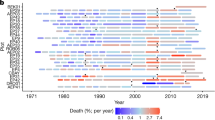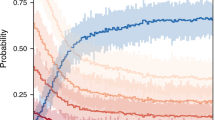Abstract
Drought-induced tree mortality is expected to increase worldwide under projected future climate changes1,2,3,4. The Canadian boreal forests, which occupy about 30% of the boreal forests worldwide and 77% of Canada's total forested land, play a critical role in the albedo of Earth’s surface5 and in its global carbon budget6. Many of the previously reported regional-scale impacts of drought on tree mortality have affected low- and middle-latitude tropical regions2 and the temperate forests of the western United States3, but no study has examined high-latitude boreal regions with multiple species at a regional scale using long-term forest permanent sampling plots7,8,9. Here, we estimated tree mortality in natural stands throughout Canada's boreal forests using data from the permanent sampling plots and statistical models. We found that tree mortality rates increased by an overall average of 4.7% yr−1 from 1963 to 2008, with higher mortality rate increases in western regions than in eastern regions (about 4.9 and 1.9% yr−1, respectively). The water stress created by regional drought may be the dominant contributor to these widespread increases in tree mortality rates across tree species, sizes, elevations, longitudes and latitudes. Western Canada seems to have been more sensitive to drought than eastern Canada.
This is a preview of subscription content, access via your institution
Access options
Subscribe to this journal
Receive 12 print issues and online access
$209.00 per year
only $17.42 per issue
Buy this article
- Purchase on Springer Link
- Instant access to full article PDF
Prices may be subject to local taxes which are calculated during checkout


Similar content being viewed by others
References
Allen, C. D. et al. A global overview of drought and heat-induced tree mortality reveals emerging climate change risks for forests. Forest Ecol. Manage. 259, 660–684 (2010).
Phillips, O. L. et al. A. Drought sensitivity of the Amazon rainforest. Science 323, 1344–1347 (2009).
Van Mantgem, P. et al. Widespread increase of tree mortality rates in the western United States. Science 323, 521–524 (2009).
Carnicer, J. et al. Widespread crown condition decline, food web disruption, and amplified tree mortality with increased climate change-type drought. Proc. Natl Acad. Sci. USA 108, 1474–1478 (2011).
Bonan, G. B. Forests and climate change: Forcings, feedbacks, and the climate benefits of forests. Science 320, 1444–1449 (2008).
Kurz, W. A. et al. Risk of natural disturbances makes future contribution of Canada's forests to the global carbon cycle highly uncertain. Proc. Natl Acad. Sci. USA 105, 1551–1555 (2008).
Piao, S. et al. Net carbon dioxide losses of northern ecosystems in response to autumn warming. Nature 451, 49–53 (2008).
Hogg, E. H., Brandt, J. P. & Michaelian, M. Impacts of a regional drought on the productivity, dieback, and biomass of western Canadian aspen forests. Can. J. Forest Res. 38, 1373–1384 (2008).
Michaelian, M., Hogg, E. H., Hall, R. J. & Arsenault, E. Massive mortality of aspen following severe drought along the southern edge of the Canadian boreal forest. Glob. Change Biol. 17, 2087–2094 (2011).
Ciais, P. et al. Europe-wide reduction in primary productivity caused by the heat and drought in 2003. Nature 437, 529–533 (2005).
Zhao, M. & Running, S. W. Drought-induced reduction in global terrestrial net primary production from 2000 through 2009. Science 329, 940–943 (2010).
Barber, V. A., Juday, G. P. & Finney, B. P. Reduced growth of Alaskan white spruce in the twentieth century from temperature-induced drought stress. Nature 405, 668–673 (2000).
Arnone, J. A. III et al. Prolonged suppression of ecosystem carbon dioxide uptake after an anomalously warm year. Nature 455, 383–386 (2008).
Cleland, E. E., Chuine, I., Menzel, A., Mooney, H. A. & Schwartz, M. D. Shifting plant phenology in response to global change. Trends Ecol. Evol. 22, 357–365 (2007).
Parmesan, C. et al. Poleward shifts in geographical ranges of butterfly species associated with regional warming. Nature 399, 579–583 (1999).
IPCC Climate Change 2007: The Physical Science Basis (eds Solomon, S. et al.) (Cambridge Univ. Press, 2007).
Phillips, O. L. et al. Drought–mortality relationships for tropical forests. New Phytol. 187, 631–646 (2010).
Williams, A. P. et al. Forest responses to increasing aridity and warmth in the southwestern United States. Proc. Natl Acad. Sci. USA 107, 21289–21294 (2010).
Lenton, T. M. et al. Tipping elements in the Earth’s climate system. Proc. Natl Acad. Sci. USA 105, 1786–1793 (2008).
Bonsal, B. R. & Wheaton, E. E. Atmospheric circulation comparisons between the 2001 and 2002 and the 1961 and 1988 Canadian prairie droughts. Atmos. Ocean 43, 163–172 (2005).
Girardin, M. P. et al. Trends and periodicities in the Canadian Drought Code and their relationships with atmospheric circulation for the southern Canadian boreal forest. Can. J. Forest Res. 34, 103–119 (2004).
Liu, J., Stewart, R. E. & Szeto, K. K. Moisture transport and other hydrometeorological features associated with the severe 2000/01 drought over the Western and Central Canadian Prairies. J. Clim. 17, 305–319 (2004).
Shabbar, A. & Skinner, W. Summer drought patterns in Canada and the relationship to global sea surface temperatures. J. Clim. 17, 2866–2880 (2004).
Cutforth, H. W. & Judiesch, D. Long-term changes to incoming solar energy on the Canadian Prairie. Agr. Forest Meteorol. 145, 167–175 (2007).
McDowell, N. et al. The interdependence of mechanisms underlying climate-driven vegetation mortality. Trends Ecol. Evol. 26, 523–532 (2011).
Raffa, K. F. et al. Cross-scale drivers of natural disturbances prone to anthropogenic amplification: The dynamics of bark beetle eruptions. Bioscience 58, 501–517 (2008).
Arnone, J. A. III et al. Prolonged suppression of ecosystem carbon dioxide uptake after an anomalously warm year. Nature 455, 383–386 (2008).
Easterling, D. R., Meehl, G. A., Parmesan, C., Changnon, S. A., Karl, T. R. & Mearns, L. O. Climate extremes: Observations, modeling, and impacts. Science 289, 2068–2074 (2000).
Kurz, W. A. et al. Mountain pine beetle and forest carbon feedback to climate change. Nature 452, 987–990 (2008).
Bond-Lamberty, B. et al. Fire as the dominant driver of central Canadian boreal forest carbon balance. Nature 450, 89–92 (2007).
Stinson, G. et al. An inventory-based analysis of Canada's managed forest carbon dynamics, 1990 to 2008. Glob. Change Biol. 17, 2227–2244 (2011).
Acknowledgements
Funding for this study was provided by the Natural Sciences and Engineering Research Council of Canada (NSERC) Strategic Network (ForValuenet), an NSERC discovery grant and the China QianRen programme. We thank the Forest Management Branch of Alberta Ministry of Sustainable Resource Development, Saskatchewan Renewable Resources Forestry Branch, the Forestry Branch of Manitoba, Ontario Terrestrial Assessment Program and Ministère des Ressources Naturelles et de la Faune du Québec, and our colleagues (P. Comeau, J. Liu, V. LeMay, S. Huang, J. Parton and K. Zhou) for providing detailed data. C.P. acknowledges the support he received during his sabbatical leave at Northwest A&F University, China. We also thank T. Hogg for his help with our calculations of CMI, P. J. van Mantgem for his assistance with our statistical models, W.Z. for her technical assistance and G. Hart for editorial help, as well as T. Moore, J. Guiot and P. J. van Mantgem for their comments and discussions on the earlier draft of the paper.
Author information
Authors and Affiliations
Contributions
C.P. contributed to the study design, data collection, method development, result analysis and writing of the manuscript. Z.M. and X.L. conducted the data analysis and developed the statistical models. All authors contributed to the data analysis, result discussion and manuscript preparation.
Corresponding author
Ethics declarations
Competing interests
The authors declare no competing financial interests.
Supplementary information
Rights and permissions
About this article
Cite this article
Peng, C., Ma, Z., Lei, X. et al. A drought-induced pervasive increase in tree mortality across Canada's boreal forests. Nature Clim Change 1, 467–471 (2011). https://doi.org/10.1038/nclimate1293
Received:
Accepted:
Published:
Issue Date:
DOI: https://doi.org/10.1038/nclimate1293
This article is cited by
-
More than 17,000 tree species are at risk from rapid global change
Nature Communications (2024)
-
Serious underestimation of reduced carbon uptake due to vegetation compound droughts
npj Climate and Atmospheric Science (2024)
-
High leaf area index expands the contrasting effect of climate warming on Western Siberia taiga forests activity before and after 2000
Journal of Geographical Sciences (2024)
-
Bedrock: the hidden water reservoir for trees challenged by drought
Trees (2024)
-
Modelling the potential of forest management to mitigate climate change in Eastern Canadian forests
Scientific Reports (2023)



